Foot Corns & Calluses
What Are Foot Corns & Calluses?
Foot corns & calluses are among the most common problems that people have with their feet. A callus is a toughened area composed of dead skin, making it thicker than the surrounding tissue. A corn is a callus that has a specific shape, which is something like an ellipse.

A callus is usually white in color and resembles a hardened blister. A corn is usually yellow in color and may be either soft or hard. Hard corns are typically found on the outside of the largest or smallest toes. Soft corns typically form between the fourth and fifth toes, but may be found between the other toes, as well.
What Are the Symptoms of Foot Corns & Calluses?
Other than the hard, rough skin, there may be no symptoms, at all. People often say that foot corns & calluses are painful, but they are composed of dead skin. So, there are no nerve endings. What is actually painful is the additional pressure placed on the joint or other part of the foot when shoes are worn.
What are the Causes of Foot Corns & Calluses?
The initial cause of a corn or callus is pressure. It may be easier to understand if you think about the calluses that form on a guitarists fingers or a bowler’s thumb. Calluses form on the hands in response to repeated friction. They actually help to protect the fingers from damage.
When a corn or callus forms on the feet, the probable cause is poorly fitting or poorly designed shoes. For example, shoes with narrow pointed toes are the most common cause.
Moisture between the toes can lead to the formation of soft corns, because of increased friction. High heeled shoes can cause the formation of corns or calluses on the balls of the feet, because of increased pressure in that area.
The shape of the corn is related to the circular rubbing pressure that is continuously placed on the foot or toe. By looking at the shape or location, you may be able to identify which shoes are doing the rubbing.
What are the Treatments for Foot Corns & Calluses?
The first step is to stop wearing shoes that place pressure on the sides of the feet or toes. Choose a suitable width, made of a softer material that applies little or no pressure.
If you must wear dress shoes made of hard leather, invest in a shoe stretcher with attachments to create a little extra space in the location of the corn or callus. The Foot Smart shoe stretcher comes highly recommended.
Insoles can be used to reduce pressure points and rubbing. Padding of various materials can be used to further reduce pressure or to cushion a blister and prevent a callus from forming.
Pumice stones can be used to smooth down calluses and a callus treatment cream can help, too. With the right shoes and a few accessories, you can say goodbye to foot corns & calluses for good.


